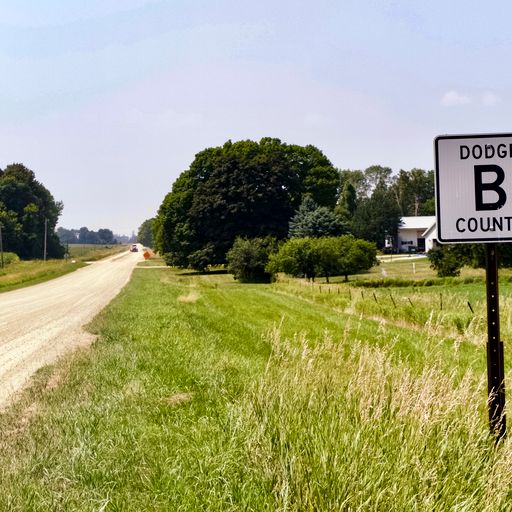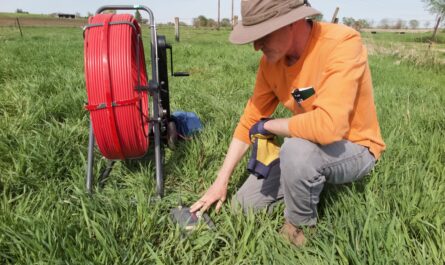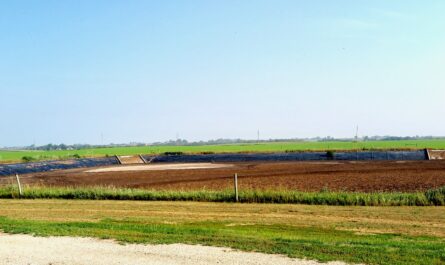
BERNE, MINN. — On a hot afternoon in mid-July, Brian Bennerotte, who was raised on a farm in the hill country south of Minneapolis in the 1960s and 1970s, made a pilgrimage of sorts to County Road B in Dodge County in his home state. Running straight as a gun barrel east and west, the gravel and dirt road crosses what was once rolling prairie before being steadily converted into crop and livestock farms in the late 19th century.
Brian, who is 60 and makes his living driving a Freightliner long haul truck , is one of three surviving members of the third generation of Bennerottes who farmed along the mile-long stretch of County Road B west of the intersection with State Highway 57. From the passenger seat of a rented vehicle he scans both sides of the road, then points to a dust-scoured barn leaning into the wind. The building is pretty much all that remains of his family’s farmstead that also held a home large enough to house five boys, a sister, his parents, a fenced-in pasture, and croplands that spread across 200 acres.
Further along he recognizes farms owned by the closest neighboring families. The Glarner farm. The Spreiter farm. The Serie farm. All are connected by circumstances of geography, topography, agriculture, and social commerce. Plus two more factors.
The first is the unusually high incidence of cancer disease and deaths along County Road B. Among the four County Road B families, 12 people developed cancer. Seven died. Three developed lymphoma, among them Bennerotte, who was nearly killed by acute lymphoblastic lymphoma in 1983 when he was 20 years old. So much disease and mortality occurred in the last decades of the 20th century that County Road B was known in the area as Cancer Road.
“Every family along here was affected. Every one,” said Bennerotte.
The second factor: elevated levels of nitrates from commercial fertilizer and manure that residents and the county found in wells used by County Road B families for drinking water. Over the last decade, an increasing number of peer-reviewed medical studies–including some of the most important conducted in the Corn Belt states–have linked exposure to nitrates in drinking water to elevated incidences of cancer.
A number of the County Road B cancers — breast, blood, colon, lymphoma — have been specifically associated in medical studies in the U.S. and overseas with exposure to nitrates in drinking water.

Groundwater along County Road B and through the rest of Concord Township has the highest levels of nitrates in Dodge County, according to the county’s water monitoring data. County water-monitoring data shows water from wells used by each of the families contained nitrate levels well above the level now considered safe.
“It’s a tough thing to pin down cancer to something specific. There are so many drivers,” said Paul D. Mathewson, who as the science program director at Clean Wisconsin, an environmental group, was lead author of a 2020 peer-reviewed study that identified nitrate contamination in drinking water as the probable cause of nearly 300 cases a year of colorectal and other cancers in Wisconsin. “But it would be worth investigating. It’s eyebrow raising that you have this cluster in this area where you have high levels of nitrates and kidney cancers and bladder and breast cancers. Those are some of the cancers that have been associated to increase risk with respect to nitrate contamination.”
Nitrates and Cancer Risk
Nitrates forms when nitrogen combines with oxygen. In Minnesota and every other state across the Corn Belt, commercial nitrogen fertilizer and nitrogen-rich livestock and poultry manure are the sources of most of the nitrates draining into surface and groundwater, according to state environment and agriculture agencies.
In the 20th Century, exposures to nitrates in drinking water were primarily considered a serious threat to infants. In the presence of nitrates, blood loses its ability to carry oxygen. In 1962, U.S. health authorities set 10 parts per million as the safe limit for nitrates in drinking water for preventing “blue baby syndrome.”
Yet even as they acted to safeguard infants, researchers theorized that nitrates also were a cancer risk. The reason is that when nitrates are ingested, they react with proteins and enzymes to form a group of chemicals called N-nitroso compounds, “which are known to cause cancer in animals and may cause cancer in humans,” according to the Centers for Disease Control and Prevention.
That thesis gained urgency in 2001 when researchers at the University of Iowa, evaluating data from a long-term study of more than 20,000 women in Iowa, found increased risks of bladder and ovarian cancers associated with elevated nitrate levels in public drinking water supplies used by the women.
The Iowa cancer finding coincided with a convergence of unsettling environmental and public health trends in rapidly industrializing Corn Belt agriculture. Thousands of cattle and hogs, and tens of thousands of chickens and turkeys, were being confined in huge manure-producing operations. Millions more acres of corn–the most heavily fertilized crop–were being put into production to feed the animals and also produce ethanol for vehicle fuel.
The consequence was a monumental new tide of nutrients spread on Corn Belt farmland and free to drain into surface and groundwater. The amount of nitrogen applied to corn has increased 120 million pounds annually since 2000, according to the U.S. Department of Agriculture. The amount of nitrogen-rich and untreated liquid and solid manure being spread on farmland–most of it in the Midwest–increased to 1.4 billion tons by 2018, according to the U.S. Department of Agriculture. As much as 70 percent of the nitrogen applied to farmland, according to many studies, leaked off fields and drained as toxic nitrates into the region’s waters.
The consequence is an urgent and demonstrable threat to public health in 10 states at the center of the country. The U.S. Geological Survey has found that 22 percent of private wells in rural areas exceed the 10 ppm safety limit for nitrate. Authorities in Minnesota reported that more than 200 public water systems exceeded the nitrate drinking water standard. In Iowa, 55,000 drinking water wells were contaminated with elevated nitrate concentrations. Private water wells serve about one-third of Wisconsin families; state authorities found 10 percent of them exceed the 10 ppm nitrate safety limit.
Nitrate contamination is getting worse. The U.S. Environmental Protection Agency reported that groundwater beneath almost a fifth of Nebraska, over 13,000 square miles, is contaminated with nitrates at more than 5 parts per million, the concentration now considered by scientists to be a health concern. Water quality data analyzed by the Environmental Working Group, a Washington-based research and advocacy group, found in 2020 that one in four residents of Illinois, Iowa, Kansas, Nebraska, and Wisconsin — 6.9 million people — were drinking nitrate-contaminated water from community water systems.
As evidence of widespread exposure to nitrates mounted, medical researchers initiated a flurry of epidemiology studies which look at large groups of people and compare those who develop cancer with those who do not. The results are drawing science ever closer to determining that exposure to nitrate in drinking water and, at much lower concentrations than the 10 ppm federal drinking water standard, is turning a demonstrable threat into a quiet health disaster in the Corn Belt.
In 2018, in a seminal peer-reviewed paper, Mary H. Ward, a National Cancer Institute researcher, led an evaluation of 30 epidemiology studies of low-level exposure to nitrates in public drinking water systems. While noting that the number of studies “are still too few to allow firm conclusions about risk,” Ward and her co-authors reported “the strongest evidence for a relationship between drinking water nitrate ingestion and adverse health outcomes is for colorectal cancer, thyroid disease, and neural tube defects.” She added that four studies found increased risk of colon cancer “associated with water nitrate levels that were mostly below the respective regulatory limits.”
In 2019 the Environmental Working Group published a peer-reviewed study that found that exposure to nitrate in drinking water was causing over 12,000 cancer cases annually in the U.S. “In the past decade or so there’s been a lot of new research making a strong, compelling case that even at nitrate levels that are much lower than 10 parts per million you’re seeing these increased risks,” said Mathewson.
“There needs to be greater awareness. The science is out there.”
A scientific consensus is emerging that nitrates in drinking water, particularly in the presence of trace levels of pesticides, increases the risk of certain cancers – colorectal, stomach, bladder and some pediatric cancers. That consensus is strengthened by new research data and front line evidence of rates of cancer in Corn Belt states that are higher, and, in some cases like Iowa and Minnesota, much higher, than the U.S. incidence of cancer.
Pediatric cancer is more common in Nebraska than anywhere west of the Mississippi River, according to researchers at the University of Nebraska Medical Center. The cases are associated with Nebraska watersheds that have high levels of nitrate or atrazine — a weed killer — in surface and groundwater. In Aurora, one particularly hard-hit town, seven children were diagnosed with cancer from 2005 to 2013 and five died.
“Our incidence of pediatric cancer is significantly higher than the surrounding states,” said Eleanor Rogan, chair of the university'”s Department of Environmental, Agricultural, and Occupational Health. “We’ve mapped the three most prevalent types of pediatric cancer in Nebraska and they are central nervous system cancers and brain tumors, that are really driving this high incidence.”
Similar alarms are sounding in other Corn Belt states. Of the 15 states with the highest cancer incidence, Iowa is second tyo Kentucky, a tobacco state. Four other states — Minnesota, Wisconsin, North Dakota, and South Dakota — are in the top 15, according to the data from the Centers for Disease Control.
“I was definitely surprised by that,” said Mary Charlton, professor of epidemiology at the University of Iowa and director of the Iowa Cancer Registry. “I don’t think anybody thought of ourselves as being a very high cancer state.”
Could environmental factors, like Iowa’s extensive nitrate contamination of surface and groundwater, be an important risk factor? “A lot of people have concerns about that,” Charlton replied. “We have data for different types of environmental exposures, including nitrates. We are working with people who are experts in those areas so that we can start looking at some of those things.â€
Nitrate Exposure at the Front Line
That hot afternoon, as Benerrotte made his way along County Road B, he listed the cancer toll, which was confirmed in email contacts and interviews with the families.
Leon and Irene Spreiter still live along Cancer Road. Irene Spreiter developed breast cancer. Their son, Darren, was diagnosed with Hodgkins lymphoma, a cancer of the lymph system, when he was 11. His cancer is in remission. As an adult, Darren moved from the farm. Christine Hachfeld moved into his home on the farm. She developed multiple myeloma.
Larry and Audrey Serie also lived on a neighboring farm. She died of cancer in 2021.

Kerry and Bonnie Glarner lived and farmed down the road. Bonnie developed breast cancer in the mid-1970s at age 35. She underwent treatment and died in 2021. Her son, Scott Glarner, lived on County Road B until he was 51 years old. He developed non-Hodgkins lymphoma in 2005, when he was 43, and is in remission.
“People talked about it,” Glarner, who serves as postmaster in nearby West Concord, said in an interview. “You know. People questioning, what’s up with the water? Because of all the cancer that people had up and down that road.”
More than any other County Road B family, cancer wrecked the Bennerottes. In separate interviews Brian and Stuart Bennerotte, the family’s last two surviving brothers, described a roster of pain they blame on exposure to contaminated well water. Brian’s father, Howard Bennerotte, farmed on County Road B his entire life. He died of kidney cancer in 1983 when he was 64 years old.
Gary, the oldest brother, developed colon cancer that led to his death in 2006 at age 65.
Chuck Bennerotte, the second brother, became the principal farm manager following the death of his father. Chuck died of bone cancer in 2000 at age 57. His wife, Joanne, also developed bone cancer and died in 2015.
Stuart, the third brother, first developed a benign tumor on his pancreas in 2003 when he was 57. Fifteen years later, he was diagnosed with prostate cancer that is being treated.
Wesley, the youngest brother, developed leukemia, a blood cancer, and died in 2019 when he was 67. The lone sister, Myrna, developed cancer, survived, and is living in Michigan.
Dodge County conducted nitrate monitoring for drinking water wells used by County Road B families that date to 1990 and continued through 2015. Nitrate levels in the Glarner family well consistently tested at 11 ppm from 2002 to 2011. The highest nitrate concentrations, 25 ppm, were found in 2001 in the Spreiters’ well. Nitrate concentrations in the Bennerottes’ well was 8 ppm in 1990 and 7.1 ppm in 2013.
Brian Bennerotte’ tumor was so large when it was discovered in the early 1980s that it wrapped around his heart and other vital organs. Doctors at the Mayo Clinic in Rochester, 40 miles away, saved his life by exposing the tumor to massive doses of radiation. They told Bennerotte that his heart and lungs would sustain permanent damage that would affect the rest of life.
He’s been in and out of hospitals ever since for heart surgery and other urgent health issues. “The doctors told me they had to save my life,” he said in an interview. “They said we didn’t have a choice, knowing that later on what they did was probably going to kill me. I live with it. My father. My brothers. They didn’t.”
— Keith Schneider
This report, co-published with Circle of Blue and The New Lede, is made possible by investigative reporting fellowships awarded by the Alicia Patterson Foundation and the Fund for Investigative Journalism. It is part of Toxic Terrain, an ongoing series looking at how industrial farm practices have produced a national scandal of environmental contamination and public health menace.


